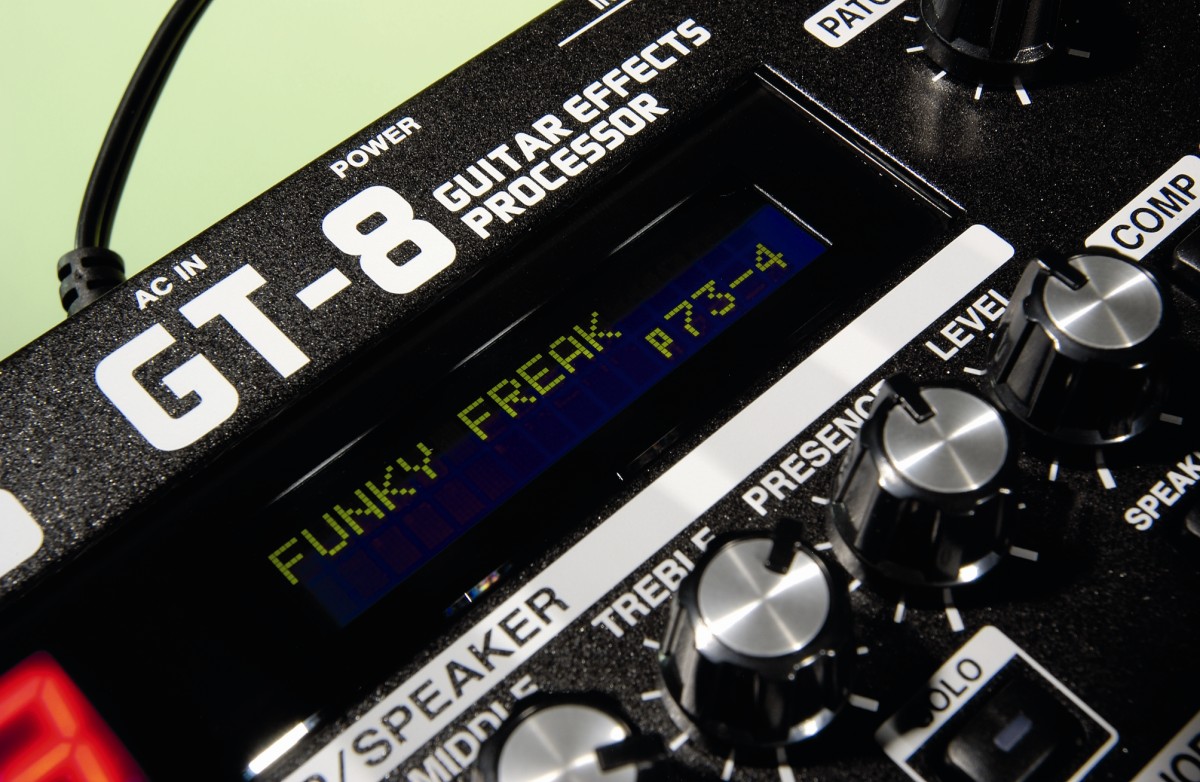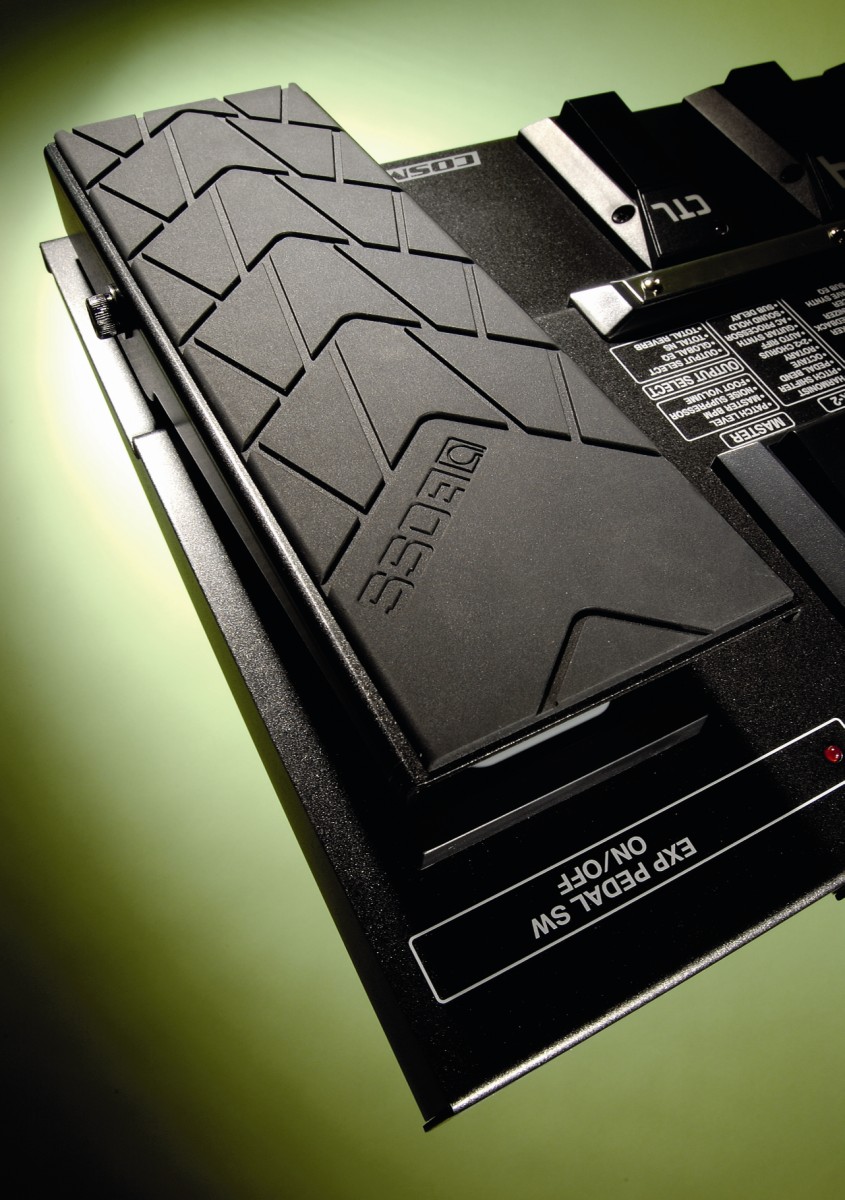MusicRadar Verdict
Extremely versatile, the GT-8 comfortably spans both the recording and live worlds without compromise.
Pros
- +
Sound build quality. Great sounds. Extreme programming versatility
Cons
- -
No USB socket.
MusicRadar's got your back



The number eight is considered lucky in Japan, which may be why Boss jumped straight from the GT-6 to the GT-8. Whether that's the case or not, this updated incarnation of the well-respected FX processor packs in some exciting new features and effects not found in its predecessor. And what's more, it is less expensive than the GT-6 was when it first appeared.
For those not already familiar with the Boss GT range, what you get is an extremely solidly constructed floor unit with a large array of knobs and switching pedals, plus a pedal treadle for volume, wah or parameter adjustment duties. The GT-8 is patch-based and contains 340 patches stored in 85 banks - a pair of bank up/down switching pedals scroll through the banks, while an array of four more select the patches within the bank. An additional control pedal can be assigned to switch particular functions within a patch (ie turning delay on/off), as can a switch at the tip of the pedal treadle. Additional external footswitches can be added to the system to increase this facility.
Each patch is a multi-effects chain, constructed from up to 13 effects blocks that can be placed in any order. The main starting block is the amp and speaker simulation, and the GT-8 has a dual COSM modelling engine allowing two different amps (or two instances of the same amp) to be assigned to a patch, providing twin channel operation and various options for combining or switching amps.
Hands-on tweaking of any amp sound is instantly carried out with front panel knobs controlling the gain and tone parameters. In fact, all of the more commonly used effects, (amp/ speaker, overdrive/distortion, delay, chorus and reverb) have dedicated rotary knobs for their main parameters. For more detailed editing of these and the effects blocks without rotary knobs (compressor, EQ, wah, FX1 and FX2), there are more parameters in easily accessible menus to be adjusted using the rotary dial and cursor buttons. For both FX1 and FX2, you can choose one from a large variety of effects including all of the more usual stuff like tremolo and phaser, plus more esoteric effects like guitar synth and sitar simulator.
New to the GT-8 is a solo mode: a specially programmed variation in each of the 46 amp models that is optimised for soloing. Basically, it's a boost that you can kick in using the control pedal. Solo is great players' facility and evidence that Boss has been working hard on features to better integrate the GT-8 into guitarists' rigs.
Another new feature along those lines is the amp control function that allows you to switch between channels on your amp by connecting a lead from the GT-8 to your footswitch socket. This switching can be done automatically with each effects patch or can be assigned to one of the pedals. Existing effects pedals can also be fully integrated by being connected in the external loop of the unit, which can be placed at any point in the signal chain and switched in with a GT-8 pedal.
Use of the GT-8 as a more conventional pedal set-up is also possible via manual mode where, rather than changing patches, the bank up/down and patch change pedals can be assigned to turn individual effects on and off. Switching from patch mode to manual mode can even be assigned to a footpedal.
Want all the hottest music and gear news, reviews, deals, features and more, direct to your inbox? Sign up here.
Sounds
Straight out of the box, the GT-8's preset patches are designed to show off the unit's attributes but, overall, they have been well chosen to cover plenty of disparate guitar styles. There are some neat switching options too that are programmed in with the control pedal - selecting channels, bringing in solo mode, turning on an effect or doing several of these things at the same time.
The 46 amp models are made up of variations on old favourites - Twin, AC30, Marshall etc - and, as simulations go, they sound pretty authentic with a detailed sound that imparts the flavour of the real thing - excellent for home recording or practising with headphones. Whether you'd want to use a load of amp models plugged into a real amp for gigging is a matter of taste but, if not, there are options to set up a neutral sound or bypass the block entirely for live work. Certainly if you were to use the sims live then the solo mode and channel switching are particularly useful. More quirky, but potentially adding an extra dimension to your playing, is 'Dynamic Sense', a new feature by which you can switch amp channels in response to picking strength, playing quietly for a clean sound and digging into the strings for more distortion.
As for the effects, there is some gorgeous stuff on offer. The delay is very versatile and just about all shades of overdrive/distortion/fuzz are on tap. It's a shame that you can only use two of the effects in the FX1/2 category simultaneously because there are some serious tone manglers in there. At the same time though, there are some impressive effects, potentially delightful to studio boffins, that you would be hard pushed to find a practical use for in a live situation. The GT-8 is not without duds either - forget that sitar simulator, buying a Jerry Jones is the only way.
The convenience of setting up patches for recall in each section of a song is tempting but there are those, this writer included, who prefer to be able to switch individual effects in and out on the fly. To a certain extent this can be carried out from within patches by using the control pedal, expression pedal switch and other functions that allows an extra press on the pedal of a selected patch to change amp channel or switch in solo mode.
However, manual mode has to be the way to go if you are a traditionalist. As an exercise you might want to replicate your existing pedalboard set-up, in our case: compressor, two overdrive levels, fuzz, tremolo, delay, reverb, tuner, volume pedal. Using manual mode, with amp simulation standing in for overdrive and the control pedal switching channels for the two levels, we were able to assign fuzz, delay, tremolo, reverb and compressor to the remaining three patch and two bank pedals, with the expression pedal controlling volume and its switch calling up the silent tuner - job done.
This was just one example but there is huge potential available in tailoring the GT-8 to suit your needs exactly and in creating some very special sounds. That said, it does require some thought and a lot of menu hopping. The amount of versatility in the unit may make it seem overwhelmingly complex to the uninitiated but a couple of hours spent with manual and machine are really all that's needed to start unleashing that potential. There are useful aids in the form of some quick settings that can be called up - so you don't need to individually program all the parameters for an individual effect or amp sound.
While the GT-8 may come in a hard-wearing practical form designed for stage use, it is every bit as at home in the studio, rivalling the Line 6 POD and others of that genre. Ease of use in this role is aided by a stereo digital output, but perhaps Boss has missed a trick here by not including a USB socket for direct connection to a computer, which could have been utilised not only as a recording output but as a means to store/reload and edit patches. The USB connection is available in the more expensive rack mounted GT Pro, but to be fair to BOSS, cost is probably the biggest factor here. And let's face it, there is already an awful lot crammed into the GT-8 for the money.
MusicRadar is the number 1 website for music makers of all kinds, be they guitarists, drummers, keyboard players, djs or producers...
GEAR: We help musicians find the best gear with top-ranking gear round-ups and high- quality, authoritative reviews by a wide team of highly experienced experts.
TIPS: We also provide tuition, from bite-sized tips to advanced work-outs and guidance from recognised musicians and stars.
STARS: We talk to musicians and stars about their creative processes, and the nuts and bolts of their gear and technique. We give fans an insight into the actual craft of music making that no other music website can.
